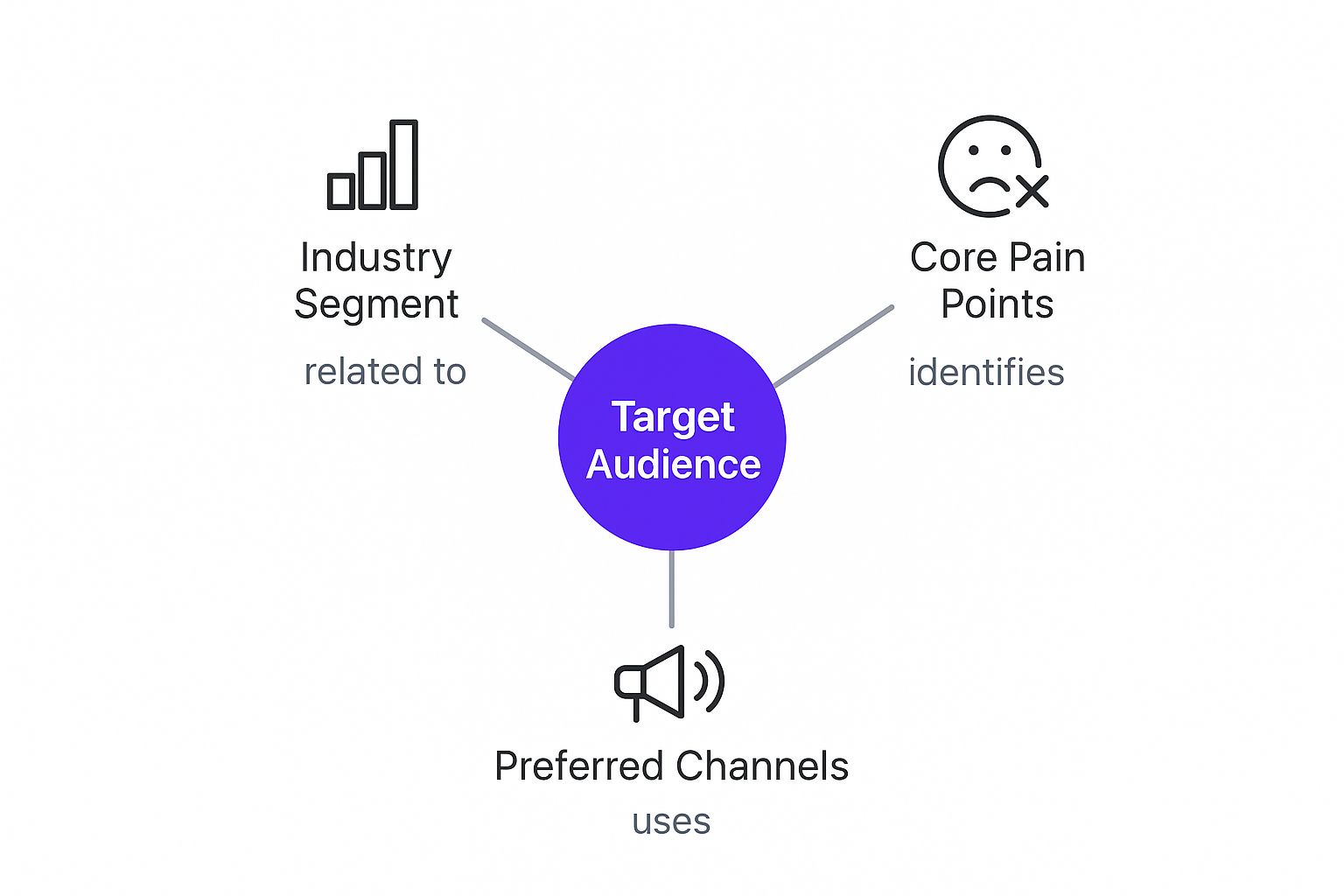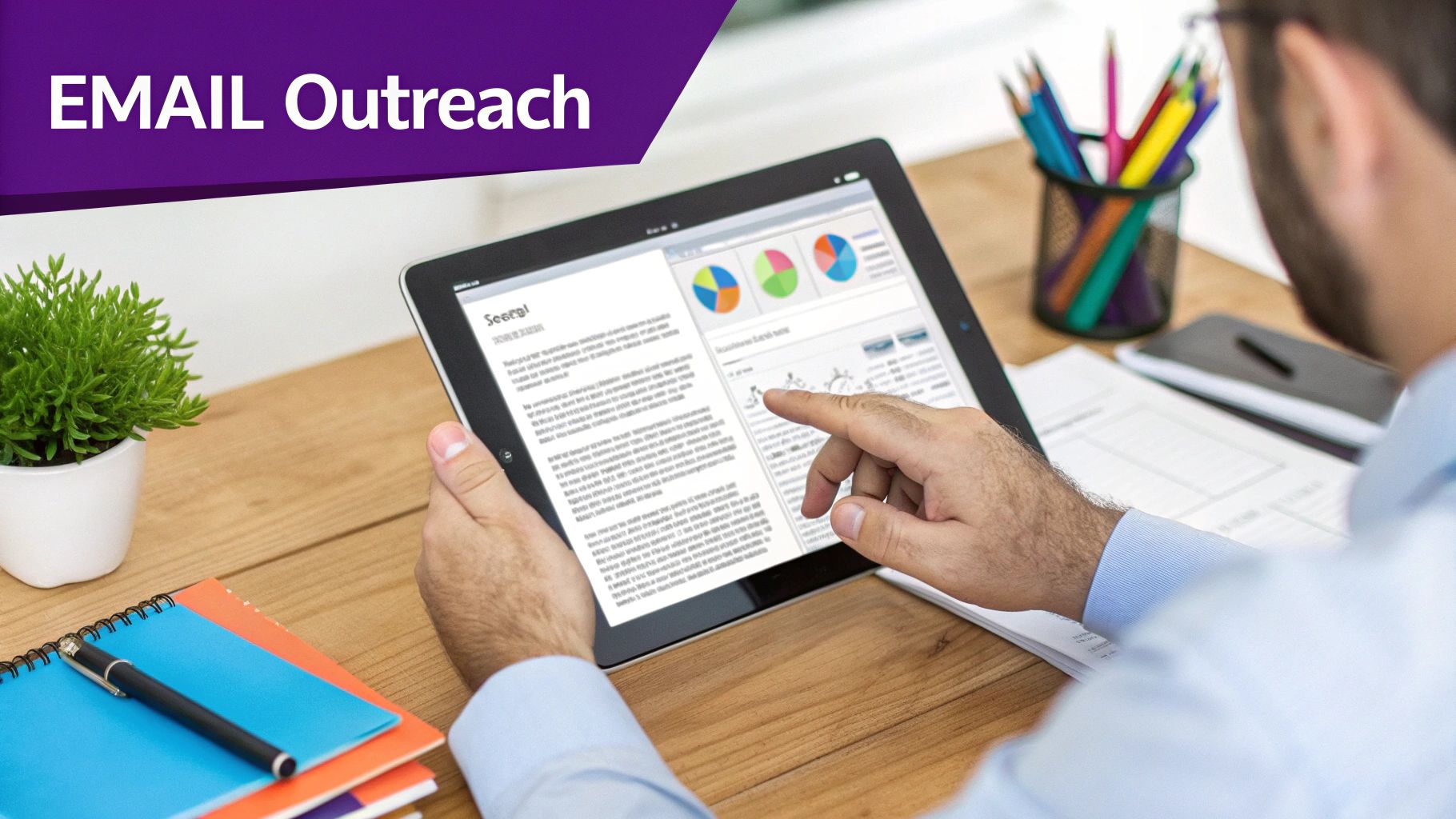Lead Generation for Professional Services Firms
Let's be real for a second. If you're still relying on aggressive cold calls and generic email blasts to drum up business, you're probably feeling the burn. It's not you; it's the playbook. The truth is, lead generation for professional services isn't about shouting the loudest anymore. It’s about earning trust and showing your expertise long before you ever ask for a meeting.
For high-trust fields like law, accounting, or consulting, this shift isn't just a trend—it's everything.
Why Your Current Lead Strategy Is Underperforming
So many professional service firms are stuck using marketing tactics from a bygone era. The old "more is more" approach—blasting out thousands of emails or dialing for dollars—just doesn't fly with sophisticated B2B clients. They're looking for a trusted advisor, not just another vendor in their inbox.
These interruptive methods often do more harm than good, chipping away at your brand's credibility before you've even had a chance to prove your worth.
The core of the problem is simple: professional services aren't commodities. Clients aren't buying a product off a shelf; they're buying your experience, your judgment, and your specialized knowledge. That's a high-stakes decision, and it demands a foundation of trust that you just can't build with a one-size-fits-all marketing blitz.
The Shift from Interruption to Attraction
Modern lead generation is all about attracting clients, not chasing them down. It’s a fundamental flip from broadcasting what you do to demonstrating your value. This means you've got to focus on activities that build your firm's reputation as a go-to resource and a genuine thought leader.
Before we dive into the "how," it's crucial to understand just how much the game has changed. Old tactics were about volume and interruption, while modern strategies are built on empathy, value, and attraction.
The Shift in Lead Generation for Professional Services
| Strategy | Interruption-based (cold calls, mass emails) | Attraction-based (inbound content, SEO) |
|---|---|---|
| Goal | Quantity of leads | Quality of leads |
| Messaging | "Here's what we sell." | "Here's how we solve your problem." |
| Relationship | Transactional | Relational & trust-based |
| Expertise | Stated in a sales pitch | Demonstrated through value |
| Mindset | Chasing prospects | Earning attention |
This table really crystalizes the transformation we're talking about. Moving from the left column to the right is the key to unlocking consistent, high-quality leads in today's market.
This infographic nails the starting point for that modern approach: getting inside your target audience's head. Understanding their industry, their biggest headaches, and where they hang out online is step one.

As you can see, a winning strategy always starts with deep client empathy. It allows you to create content and campaigns that speak directly to their needs, making you a magnet for the right kind of business.
The Opportunity in a High-Trust Market
Here’s the good news. The professional services world has a massive advantage. While lead conversion efficiency varies wildly across industries, professional services boast one of the highest rates globally at 4.6%.
That's way higher than B2B e-commerce (1.8%) and most B2C sectors (2.1%). If you want to dig deeper, you can find out more about these lead generation statistics and trends. This tells us one thing loud and clear: when you connect with the right prospect, they are far more likely to become a client.
The key takeaway is simple: quality trumps quantity. A handful of well-qualified leads generated through trust-building activities will always be more valuable than hundreds of cold, unqualified contacts. Your goal is to create a system that consistently delivers these high-quality opportunities by proving your worth long before a sales conversation ever begins. This guide provides a clear path to building that system.
Building Your Authority with SEO and Content

This is where we flip the script. Stop chasing clients and start making them come to you. Forget the generic SEO advice you've heard a thousand times. For high-trust professional services firms, the game is different. The real goal is to become the first and only resource your ideal clients think of when they’re Googling their biggest business headaches.
It all starts with getting inside your prospects' heads, figuring out their most pressing problems, and then creating knockout content that solves them. This isn't about tricking the algorithm; it's about being so genuinely helpful that you prove your expertise without saying a word.
And this strategy isn’t just a “nice to have” anymore. Lead generation is a top priority for roughly 50% of marketers. A whopping 76% are already using content specifically to pull in leads, cementing its spot as a core pillar of business development.
Pinpoint Client Problems for Content That Actually Hits Home
The best content strategies are built on a deep, almost obsessive understanding of your client's world. Think about it: what really keeps a manufacturing executive up at night? It’s not "supply chain consulting services." It's "how do I stop these shipping delays?" or "what happens if my single-source supplier goes under?"
Your content needs to speak that language. When you address the real-world problems your clients are trying to solve, you instantly position your firm as an insightful partner, not just another vendor peddling services.
So, how do you find these golden topics?
- Go straight to the source. Pick up the phone and interview your best clients. Ask them what their world looked like before they hired you.
- Listen to your frontline troops. Your sales and client service teams are in the trenches every day, hearing unfiltered concerns and frustrations.
- Use SEO tools as your listening device. Dig for long-tail keywords that reveal what people are actually typing into Google, like "tax implications of international expansion for SaaS."
This research isn't just a box-ticking exercise. It becomes the bedrock of your entire content calendar, ensuring every single article, white paper, or webinar is a magnet for the right kind of prospect.
Create Pillar Content That Establishes You as the Expert
Once you know the problems, it's time to build your "pillar content"—those big, comprehensive, in-depth resources that cover a topic from every angle. For a professional services firm, these aren't just blog posts. They're digital assets that scream authority.
For example, that consulting firm targeting manufacturing execs? They could create the definitive guide to supply chain optimization. This wouldn't be a thinly veiled sales pitch. It would be a meaty, valuable resource packed with frameworks, real-world case studies, and checklists they can actually use.
Key Takeaway: Pillar content acts like a lighthouse for high-quality leads. It's the kind of stuff decision-makers download, save, and forward to their entire team. By the time they're ready to make a call, your firm is already positioned as the go-to expert.
This approach also happens to be exactly what Google wants to see. It directly builds your website's Expertise, Authoritativeness, and Trustworthiness (E-A-T)—critical ranking factors, especially in high-stakes fields like finance and law. To learn more, check out our deep dive into SEO for professional services firms.
Nail the On-Page and Local SEO Fundamentals
Even the greatest content in the world won't do you any good if no one can find it. For professional service firms, getting the technical foundation right with on-page and local SEO is absolutely crucial for a successful lead generation for professional services plan.
On-Page SEO Best Practices
Titles and Headings That Make Sense: Your page titles and H1/H2 headings need to clearly state what the content is about and naturally include the keywords you're targeting.
Clean, Logical URLs: Keep your URLs simple and descriptive, like /guides/supply-chain-optimization. No gobbledygook.
Smart Internal Linking: Link your pillar content to relevant service pages and other blog posts. This guides users through your site and spreads SEO authority around.
Local SEO for Firms Tied to a Place
If you have a physical office or serve a specific city or region, local SEO isn't optional. It’s how you show up when someone searches for a service "near me."
- Own Your Google Business Profile (GBP): Fill out your GBP listing completely. Add great photos, keep it updated, and—most importantly—encourage happy clients to leave reviews. Social proof is pure gold.
- Create Location-Specific Pages: Build out dedicated pages on your site for each office, showcasing local case studies, testimonials, and contact info.
- Keep Your Citations Consistent: Make sure your firm's name, address, and phone number (NAP) are identical across every online directory, from Yelp to industry-specific sites.
Combine this deep, problem-solving content with smart SEO, and you create a powerful engine for attracting high-quality leads. You stop being just another firm shouting for attention and become the trusted authority clients actively seek out.
Winning High-Value Clients on LinkedIn
For any serious professional services firm, LinkedIn isn't just another social media site. Think of it as the digital version of the most exclusive industry conference you've ever attended. It’s a non-negotiable part of your growth strategy, but only if you use it with precision and real intent.
The trick is to stop seeing it as an online resume holder. Instead, treat it like a dynamic stage where you can showcase your expertise, build real relationships, and connect directly with the exact decision-makers you want as clients.
Your Profile Isn't a Resume, It's a Billboard
First things first: the personal profiles of your firm's key partners and leaders need a serious makeover. An effective lead generation for professional services plan starts here. A powerful brand begins with a profile that screams value, not just history. Check out these tips for crafting a winning LinkedIn profile headline to instantly show people what you're all about.
Don't just say "Partner at ABC Law Firm." That’s boring and tells me nothing.
Try something like, "Partner at ABC Law Firm | Guiding Tech Startups Through Complex IP and Funding Rounds." See the difference? One is a title; the other is a solution. It immediately shifts the focus from who you are to how you solve problems for a very specific audience.
Beyond the headline, a few other tweaks are critical:
- A Professional Headshot: This feels obvious, but a high-quality, approachable photo builds trust in a split second. No vacation photos, please.
- A Compelling "About" Section: This is your spot to tell a story. Talk about your philosophy, share some big wins (anonymized, of course), and be crystal clear about who you help and how you do it.
- Rich Media: Got published articles, firm white papers, or videos of you speaking at an event? Add them to your "Featured" section. This is tangible proof that you know your stuff.
Pinpoint Your Ideal Clients with Surgical Precision
Once your profiles are sharp, the real work starts. Tools like LinkedIn Sales Navigator are your best friend here, helping you move from a scattergun approach to a highly targeted one. The filtering capabilities go way beyond the standard search.
This screenshot shows just how deep you can go with Sales Navigator's filters—industry, company size, seniority, even recent job changes.
What does this look like in practice? A financial advisory firm can build a hyper-specific list of CFOs at mid-sized manufacturing companies in the Midwest who have been in their role for less than a year. Now that's an audience primed for their services.
Expert Insight: The real magic of Sales Navigator isn't just finding people; it's understanding their context. Use the "Lead Alerts" to see when a prospect is mentioned in the news or changes jobs. These moments create the perfect, natural opening for outreach that feels timely and relevant, not cold and random.
Engage Meaningfully to Build Trust (Don't Just Sell)
You've got your list. Now what? You engage—and I don't mean you start selling. The goal is to become a familiar, trusted voice in their world before you ever send a connection request.
- Join Niche Groups: Find the LinkedIn Groups where your ideal clients actually hang out. Don't just drop links to your own content. Answer questions, offer genuine insights, and have real conversations.
- Share High-Value Content: Post content that actually solves your clients' problems. They don't care about your firm's latest award. They care about analysis, commentary, and practical advice that makes them better at their job. Our guide on how to master B2B marketing on LinkedIn offers a deeper playbook on this.
- Comment Intelligently: Spend 15 minutes a day leaving thoughtful comments on posts from your target prospects or industry influencers. One meaningful comment that adds to the conversation is worth more than a hundred "likes."
Convert Interest with Frictionless Lead Forms
All this consistent, value-driven engagement will naturally create opportunities. When it's time to convert that interest into a lead, LinkedIn's Lead Gen Forms are a game-changer.
When someone clicks on an ad for your webinar or white paper, their LinkedIn info pre-populates the form. This makes signing up incredibly easy and removes almost all friction.
This simple feature is why around 40% of B2B marketers say LinkedIn is their most effective channel for high-quality leads. The data doesn't lie: LinkedIn's Lead Gen Forms can hit a 13% conversion rate, blowing the typical website landing page average of 2.35% out of the water. By pairing targeted content with these streamlined forms, you create a direct and powerful path from prospect to lead.
Building a Proactive Referral Engine

For most professional services firms, referrals are the absolute lifeblood of the business. Let's be honest—they're warm, highly qualified, and almost always convert at a much higher rate than any other lead source.
And yet, the vast majority of firms treat them like happy accidents. A welcome surprise, sure, but not the result of a deliberate, repeatable system.
This passive approach is a massive missed opportunity in lead generation for professional services. It's time to stop waiting for referrals to fall into your lap and start building an engine that delivers a consistent flow of ideal clients. This means shifting your mindset from hoping for business to actively creating the relationships that generate it.
The whole process kicks off when you look beyond your existing client base and start identifying complementary professionals—people who serve the same audience but don't compete with you.
Identify and Nurture Strategic Partners
Your ideal referral partners are the other trusted advisors your clients already work with. Just think about the ecosystem surrounding your clients. If you're a business attorney, your natural partners are accountants, fractional CFOs, and commercial insurance brokers.
These partnerships thrive on mutual value. You’re not just asking for leads; you’re creating a symbiotic relationship where you can send qualified business their way, too. The key is to be strategic and systematic in how you reach out and build these connections.
- Create a "Dream 100" List: Pinpoint 100 professionals in complementary fields you’d love to have as referral partners.
- Provide Value First: Before you ever ask for a thing, find ways to help them. Share their content on LinkedIn, introduce them to a potential client, or send a valuable industry report their way. It’s all about giving before you get.
- Schedule "Get to Know You" Calls: Reach out with one simple goal: to learn about their business and ideal client. This low-pressure approach builds genuine rapport and uncovers natural ways to collaborate.
Don’t just collect business cards. The goal is to build a small, powerful network of true partners who deeply understand what you do and who you serve. A handful of these strong relationships will generate more high-quality leads than a hundred superficial connections.
This strategy definitely requires patience, but it lays the foundation for a sustainable referral pipeline that operates on trust and mutual benefit, not just random chance.
Create a Formal Partner Program
Once you've established a few strong, informal relationships, putting a little structure around the process can seriously ramp up the volume and quality of referrals. A simple partner program removes any ambiguity and gives people a clear incentive to send business your way.
This doesn't need to be some overly complicated legal document. A straightforward program might include a tiered referral fee for closed business, but honestly, the most effective incentives often aren't financial at all.
Consider offering things like:
- Co-marketing opportunities: Host a joint webinar or co-author a white paper. This gives your partners valuable exposure to your audience.
- Reciprocal referrals: A "send one, get one" philosophy is powerful. Make it clear you are just as committed to helping them grow.
- Exclusive content: Give partners special market updates or checklists they can share with their own clients to add value.
By creating a structured program, you elevate your referral efforts from a casual favor to a professional business arrangement. It signals that you take partnerships seriously and are committed to mutual success, a core component of effective lead generation for professional services firms.
Ultimately, it gives your partners a clear reason to think of you first whenever a need arises with one of their clients.
Nurturing Leads into Lasting Client Relationships

Scoring a new lead feels like a win, but let’s be honest—it’s just the opening bell. The real fight, where most professional service firms either land the knockout or get knocked out, happens in the follow-up.
This is where a smart nurturing system comes in. It’s all about building trust and showing off your expertise without ever coming across as pushy. Think of it as continuing the conversation you already started, gently guiding prospects from a flicker of interest to a confident handshake.
Skipping this part is like spending a fortune to get people in the door and then just staring at them blankly. Not every lead is ready to sign on the dotted line today. In fact, most are just kicking the tires. Your job is to stay top-of-mind by being consistently helpful, so when they are ready, you’re the only logical choice.
Stop Blasting Everyone With The Same Message
The bedrock of any nurturing that actually works is segmentation. Sending the same generic email to every single lead is a fast track to the unsubscribe list. It’s lazy. Instead, you need to group leads based on why they raised their hand in the first place.
This simple act of organizing lets you get personal, and personal is powerful. Someone who downloaded a white paper on "Q4 Tax Planning for Startups" has a totally different mindset than a CFO who attended your webinar on "Mergers and Acquisitions."
Here’s how we typically break it down:
- Content Topic: Group 'em by the subject of the guide, checklist, or webinar they wanted.
- Industry: Talk their language. Your follow-up for a construction firm should sound different than one for a tech company.
- Company Size: A small business owner’s headaches are worlds away from an enterprise exec’s.
Getting this right makes your communication feel relevant and insightful, not like spam. This is a core part of effective lead generation for professional services, and it all comes down to smart email list management.
Build An Automated Sequence That Doesn't Feel Automated
Once your leads are sorted into logical buckets, you can build automated email sequences that deliver the right message at the right time. The goal here is to educate and build rapport, not to shove a sales pitch down their throat.
Key Insight: Whatever you do, don't ask for a meeting in your first follow-up. It’s too soon. Instead, offer another piece of value—a related case study, a short video explaining a key concept from the guide they downloaded. Use a "give, give, ask" approach to build some serious goodwill first.
This is where a simple CRM (Customer Relationship Management) system earns its keep, even for a small firm. It handles the delivery automatically, ensuring no high-value opportunity ever falls through the cracks. Of course, the automation is useless if the emails themselves are bad. Take some time to learn about crafting professional emails that get replies to make every touchpoint matter.
A Practical Blueprint for Nurturing
Let’s get practical. Say a prospect just downloaded your firm’s guide to supply chain optimization. What happens next?
Here is a simple 5-touch email sequence designed to build trust and guide them toward a consultation without being aggressive.
Example Nurturing Sequence for a Downloaded Guide
| Email 1 | Immediate Delivery | Deliver the requested guide and set expectations. |
|---|---|---|
| Email 2 | Follow-Up Value (Day 3) | Share a case study of a client who implemented the guide's advice. |
| Email 3 | Address Common Pains (Day 7) | Discuss a common challenge related to the topic, offering a new tip. |
| Email 4 | Introduce a Person (Day 12) | Profile one of your firm's experts with a short video on the topic. |
| Email 5 | The Soft Call-to-Action (Day 18) | Offer a no-obligation call to discuss their specific challenges. |
This value-first approach methodically builds trust and positions your firm as the go-to authority. By the time you finally ask for the meeting, the prospect already feels like they know you, making them far more likely to say yes.
Measuring What Matters for Sustainable Growth
You can't improve what you don't measure. A killer lead generation for professional services strategy isn't built on guesswork—it’s fueled by data-driven decisions that create predictable growth. But with a million metrics to track, it's dangerously easy to get lost in a sea of vanity numbers that look good but don't actually move the needle.
Forget fixating on things like social media likes or raw website traffic. While they might give you a nice little ego boost, they don't tell you if your marketing is actually landing clients. To build a system that gets smarter over time, you have to focus on the key performance indicators (KPIs) that truly matter.
The Three KPIs That Drive Growth
To cut through all that noise, I always tell firms to obsess over just a handful of metrics that connect their marketing spend directly to revenue. These are the numbers that should dictate your strategy and budget, month in and month out.
- Cost Per Qualified Lead (CPQL): This is your most critical top-of-funnel number. It calculates exactly how much you're spending to get a good lead in the door—not just any random form submission. If your CPQL from a certain channel is sky-high, it’s a big red flag telling you to re-evaluate your approach there.
- Lead-to-Client Conversion Rate: This one’s simple but powerful. It measures the percentage of your qualified leads that actually sign on the dotted line and become paying clients. It’s the ultimate report card for your sales and nurturing process. A low conversion rate often points to a problem in your follow-up, not your lead generation.
- Client Lifetime Value (CLV) by Channel: This is the ultimate measure of marketing success. It shows you the total revenue a client brings in over their entire relationship with you, traced all the way back to the marketing channel that brought them to you. Knowing a client from LinkedIn is worth $50,000 over three years, while a PPC client is worth $20,000, is the kind of insight that changes everything.
By zeroing in on these three core metrics, you shift from just being busy with marketing to being truly effective. You get the clarity you need to double down on what’s working and systematically fix what isn’t, creating a real engine for growth.
Conducting a Simple Monthly Marketing Review
You don't need some ridiculously complex business intelligence platform to get this done. A simple monthly review using tools you probably already have can give you all the insight you need to make smarter decisions.
Just pull your data from three main sources:
Google Analytics: This is where you'll track your website lead sources.
Your CRM: This is your command center for monitoring lead progression and conversion rates.
Platform-Specific Analytics: Think your LinkedIn Ads or Google Ads dashboards.
By sitting down and analyzing this data once a month, you can answer the questions that matter: Which blog posts are bringing in the best leads? Is our referral program delivering high-value clients, or just a bunch of duds?
This consistent review cycle is what empowers you to fine-tune your entire lead generation machine, ensuring every dollar you invest in marketing delivers a tangible, predictable return.
At Rebus, we transform data into actionable strategies that drive real business growth. If you're ready to build a lead generation system that delivers measurable results, let's talk. Explore our lead generation services to learn how we can help you attract and convert your ideal clients.
